225 episodes

Mark Wilson: Fast Company's Global Design Editor on design's defining moments in 2025
2025-12-31 | 42 mins.
As 2025 draws to a close, it’s time to pause and take stock of what’s been a transformational year in design. From Figma’s landmark IPO to the rise of AI across every category of product, to major brand evolutions at Nike, Netflix, and The New York Times—this year has been defined by what our guest today calls “mass acceleration.” Visit our Substack for bonus content and more: https://designbetterpodcast.com/p/mark-wilson Mark Wilson is the Global Design Editor at Fast Company, where he’s been tracking these seismic shifts, reporting on everything from the architecture of data centers to the comeback of wired headphones. He’s a journalist who straddles multiple worlds—covering the design industry, and now co-hosting the By Design podcast. He’s someone who can explain why Labuboos became an unlikely cultural phenomenon and why your kids might be more interested in building with Chompsaw than staring at a screen. Today, we’re looking back at 2025 with Mark to understand not just what happened, but what it all means. We’ll explore the biggest moments in design and business, and tackle the uncomfortable questions about AI—are we in a bubble? Is it actually making us more productive? And what does the future hold for designers in an automated world? We’ll also dig into the design industry’s blind spots, the problems that aren’t getting solved because they’re not sexy or VC-fundable, and why there’s a growing hunger for physical craft and working with our hands in a world increasingly mediated by screens.

Video Rewind: Cassie McDaniel: How Medium eliminated its PM function and started moving faster
2025-12-24 | 27 mins.
We’re taking a holiday break, so we’re rewinding to one of our favorite episodes this year with Cassie McDaniel, Medium’s head of design. We’re also including video from the episode, which you can watch here or on our YouTube channel at dbtr.co/youtube. We hope you have a lovely holiday season with your family, friends, and loved ones. —Eli & Aarron *** Cassie McDaniel, Medium’s head of design, is someone with a clear vision for how a design team should work. She believes team members should have a breadth of skills, craft should be the foundation of product design, and experimentation is important in both work and workflow. To that end, Cassie and the leadership team at Medium recently made what some might see as a controversial decision: They eliminated product management. The result? They are moving faster than ever. We chat with Cassie about what led to this decision—and why it might not work for all teams, how she thinks about balancing Medium’s legacy of thoughtful design while moving the product forward, and how writing can help you advance your design career. *** Premium Episodes on Design Better This ad-supported episode is available to everyone. If you’d like to hear it ad-free, upgrade to our premium subscription, where you’ll get an additional 2 ad-free episodes per month (4 total). Premium subscribers also get access to the documentary Design Disruptors and our growing library of books: You’ll also get access to our monthly AMAs with former guests, ad-free episodes, discounts and early access to workshops, and our monthly newsletter The Brief that compiles salient insights, quotes, readings, and creative processes uncovered in the show. And subscribers at the annual level now get access to the Design Better Toolkit, which gets you major discounts and free access to tools and courses that will help you unlock new skills, make your workflow more efficient, and take your creativity further. Upgrade to paid

Aaron Draplin: Field Notes co-founder on what skate culture taught him about design
2025-12-17 | 27 mins.
A larger than life figure in the creative world, Aaron Draplin has been designing everything from logos to posters since 1995. Few designers are as prolific as Aaron. He’s the founder of Draplin Design Co. (DDC). Priding himself on craftsmanship and quality, the DDC has made stuff for Field Notes, Esquire, Nike, Red Wing, Burton Snowboards, Ford, and he’s even designed a US stamp. Visit our Substack for bonus content and more: https://designbetterpodcast.com/p/aaron-draplin We caught up with Aaron in person at The James Brand studio in Portland, Oregon, where he walked us through an origin story that begins with a meteor in Navajo country and winds through the skate parks of Michigan in the 80s, the snowboard culture of the 90s, and eventually to one of the most recognizable voices in American graphic design. But this isn’t just a conversation about making cool stuff—though there’s plenty of that. Aaron opens up about the work ethic he learned from his parents, and why being prolific isn’t about perfection—it’s about experimentation, and loving your work enough to show up every single day. We talk about collecting, organizing thousands of ideas, and what it means to run a design practice where you can still work on your own terms. And throughout it all, Aaron brings the humor, the heart, and the hard-won wisdom of someone who’s never forgotten what it’s like to work a crappy job—and who reminds himself every day just how cool a life in graphic design really is. Bio Aaron Draplin was born in Detroit in 1973 and raised in the small village of Central Lake in Northern Michigan—population 800. After a brief stint at Northwestern Michigan Community College, he moved west to Bend, Oregon at 19 to chase the snowboarding life, and started designing graphics for Solid Snowboards. To fund his winters, he worked summers as everything from a traveling fair pizza wagon cook, to a dishwasher in Anchorage, Alaska. He eventually returned to the Midwest to finish his design degree at Minneapolis College of Art and Design, before heading back west to become art director of Snowboarder Magazine in Southern California. In 2002, he moved to Portland to work as a senior designer at Cinco Design, where he worked on brands like Gravis, Helly Hansen, and Nixon. In 2004, Aaron founded Draplin Design Co., working with clients ranging from Nike and Patagonia to Sub Pop Records and the Obama Administration. In 2009, he co-founded Field Notes with Jim Coudal and Coudal Partners—a collaboration that would become one of the most successful and beloved stationery brands in America. That same year, he gave his first public talk, which spiraled into a speaking career that’s now reached over 580 engagements worldwide. His book Pretty Much Everything was published by Abrams in 2016 and is now in its 13th printing. At 51, Aaron continues to run his fiercely independent design practice from a backyard shop in Portland, Oregon. *** This is a premium episode on Design Better. We release two premium episodes per month, along with two free episodes for everyone. Premium subscribers also get access to the documentary Design Disruptors and our growing library of books: You’ll also get access to our monthly AMAs with former guests, ad-free episodes, discounts and early access to workshops, and our monthly newsletter The Brief that compiles salient insights, quotes, readings, and creative processes uncovered in the show. And subscribers at the annual level now get access to the Design Better Toolkit, which gets you major discounts and free access to tools and courses that will help you unlock new skills, make your workflow more efficient, and take your creativity further. Upgrade to paid

Jessica Hische and Chris Shiflett: Designing business tools that support how creatives actually work
2025-12-09 | 1h 8 mins.
Jessica Hische and Chris Shiflett first crossed paths at Studiomates, a Brooklyn based co-working space where some of New York’s most talented designers built businesses and influential organizations. Visit our Substack for bonus content and more: https://designbetterpodcast.com/p/jessica-hische-and-chris-shiflett Jessica, known for her lettering and illustration work with clients like Wes Anderson and The New York Times, and Chris, whose career spans from the early foundations of the web to co-founding Brooklyn Beta, both experienced firsthand what happens when passionate, independent creatives come together. Today, they’re channeling those lessons into Studioworks, a business platform built specifically for independent studios and creative professionals. They’re tackling the unglamorous but essential parts of running a creative practice—invoicing, project management, client relationships—with the same care and community spirit that defined those Brooklyn days. In this conversation, we talk about the magic of Studiomates and Brooklyn Beta, what they learned from running their own studios for years, and why they decided to bootstrap a tool for the creative community rather than chase venture capital. It’s a story about building something sustainable, beautiful, and genuinely useful for the people who make things. Bios Jessica Hische is one of the most beloved and influential designers of the past two decades. She’s best known for her lettering and illustration, but equally for her generosity in sharing what she knows. Jessica was part of the original Studiomates community in Brooklyn, has worked with clients like Wes Anderson, The New York Times, and Penguin Books, and now brings her creative leadership to Studioworks, where she and Chris are building better tools for independent creatives and small studios. Chris Shiflett is a longtime friend of the design community whose career spans the deep foundations of the early web and the heart of the creative world. His early books on HTTP and web security became unexpectedly influential at a time when the internet was still taking shape, opening the door to some extraordinary projects — including one that generated nearly half of the internet’s traffic and another responsible for a fourth of the world’s email. After years helping big internet companies solve scalability problems, he realized he was more inspired by the people creating them — the designers, founders, and builders making things people love. That shift led him to the original Studiomates community, to co-founding Brooklyn Beta, and ultimately to the work he and Jessica are doing today with Studioworks. Premium Episodes on Design Better This ad-supported episode is available to everyone. If you’d like to hear it ad-free, upgrade to our premium subscription, where you’ll get an additional 2 ad-free episodes per month (4 total). Premium subscribers also get access to the documentary Design Disruptors and our growing library of books: You’ll also get access to our monthly AMAs with former guests, ad-free episodes, discounts and early access to workshops, and our monthly newsletter The Brief that compiles salient insights, quotes, readings, and creative processes uncovered in the show. And subscribers at the annual level now get access to the Design Better Toolkit, which gets you major discounts and free access to tools and courses that will help you unlock new skills, make your workflow more efficient, and take your creativity further. Upgrade to paid

2025 Holiday Gift Guide
2025-12-04 | 44 mins.
It’s that time of year again—our favorite episode to put together. A moment to look back at the objects, experiences, and ideas that sparked creativity for us this year. From books that moved us to tools that surprised us to experiences we can’t stop recommending, we’ve gathered a set of gift ideas for the designers, makers, and curious people in your life (including you). We’re starting with budget-friendly picks and moving up from there, so whether you’re filling a stocking or going big, you’ll find something here. Let’s get into it. *** Before we get to the list, if you’re looking to give (or get) the gift of education, for the next week only you can get or gift a year of premium for 25% off, our only sale of the year. Buying a year-long subscription will get you to our ever-expanding Design Better Toolkit (with over $2K in discounts on tools and courses), as well as monthly AMAs, ad-free episodes, and our library of books. Doing this also supports anyone who can’t afford a subscription through our scholarship program. 25% off a year, expires in 1 week *** Find the full gift list on our Substack: https://designbetterpodcast.com/p/2025-holiday-gift-guide
More Arts podcasts
Trending Arts podcasts
About Design Better
Listen to Design Better, The Jann Arden Podcast and many other podcasts from around the world with the radio.net app

Get the free radio.net app
- Stations and podcasts to bookmark
- Stream via Wi-Fi or Bluetooth
- Supports Carplay & Android Auto
- Many other app features
Get the free radio.net app
- Stations and podcasts to bookmark
- Stream via Wi-Fi or Bluetooth
- Supports Carplay & Android Auto
- Many other app features


Design Better
download the app,
start listening.

































